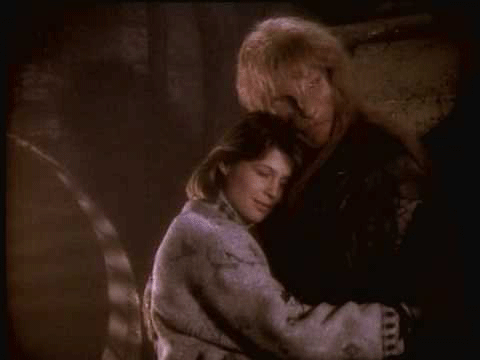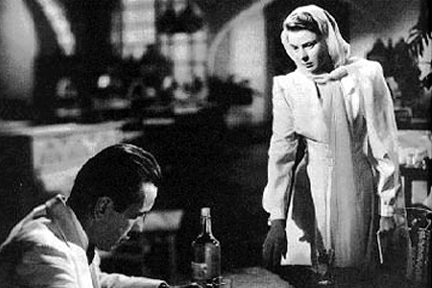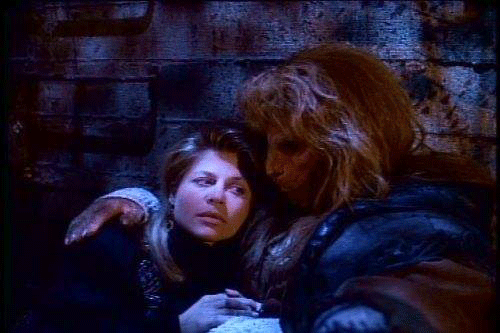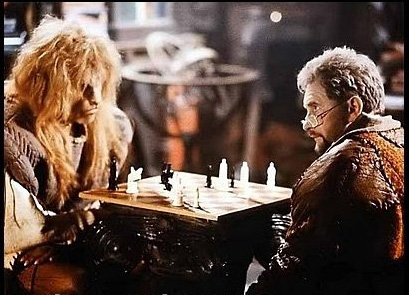Recently, just for kicks, I watched the DVD set for the first season of the 1980s show Beauty and the Beast. If you are unfamiliar with it, it takes the traditional fairy tale element of a lost beauty and a man trapped in the form of a beast and rearranges some things.

In the series, Catherine Chandler lives in a tower apartment, leading a life as a bored socialite who has chosen to work as an investigator for the D.A.’s office (she’s a lawyer).

Her “beast,” Vincent, lives deep under New York City in tunnels and spaces the city has forgotten, with other fugitives from the surface world. But Vincent is no ordinary man. He is a strange human-lionine hybrid, with a mysterious origin not even he knows. He is inescapably a beast, with no spell-breaker for his future that will release him from his alienation from mankind.
Against this set-up, the pair develop a strong, empathic bond when Vincent rescues Catherine from a vicious assault. The stories are about events in Catherine’s world or Vincent’s and how the pair work as a bonded team to resolve the current issue.
All well and good. But this show (or this season of it, at least) is written without a single drop of subtext. Everyone says exactly what they are feeling or thinking. Catherine expresses her love for Vincent and her anguish at the impossible relationship. (Unlike a science fiction show were cross-species relationships may be plentiful, this one is presented as unworkable — somehow.) Vincent moons about the depth of feeling that has come to him from knowing Catherine. Father (so called because he acts as such to the tunnel dwellers and to Vincent) disapproves of the relationship, protective of Vincent and concerned that Catherine will reveal their secret dwelling places.
The show was popular at the time. Ron Perlman was wonderful as Vincent, under an incredible amount of prosthetic make-up. Linda Hamilton conveyed a special mix of appealing vulnerability and steely determination. The quality of the casting made the lack of subtext less damaging to the whole.
But it never felt quite real because of the lack of subtext. It definitely felt like a fairy tale. Earnest declarations filled each episode, because they weren’t going to “waste” time leaving anything to doubt. Given the blatant presentation of Vincent’s nature, it was perhaps necessary to go the direct route. The series would have been too slow if Catherine’s attraction and response to Vincent was not clear from the beginning.

But looked at from the present, there is a definite stiltedness to the series. It still has its charms, primarily in the performances of the principal actors. But it is definitely quaint.

It was after I had watched the full season of the original series that I learned the CW would be launching a rebooted version this fall. In the new version, Catherine Chandler, now called “Cat” (we’re apparently not getting too far from lack of subtext!) is a homicide detective, and Vincent is a doctor and “military experiment gone awry.” He still lives in hiding, but his “beastly” nature now manifests only when he’s enraged (shades of The Hulk!)
The new premise has possibilities, but it is quite evident that the soft, romantic fairy tale atmosphere of the original show will not be part of the reboot.
Considering these two versions of the show has led me to muse on the nature of subtext in storytelling and its appeal. Certainly, in real life, it is unusual for us to be entirely straightforward. It isn’t a question of being dishonest as much as it is of being self-protective and cautious. We approach things indirectly very often, because we are uncertain what sort of response we might get. So, when characters in stories are straightforward and honest, it’s usually harder for us to get a grasp on them.
Using subtext allows us to fill out the textures of a character’s personality. Say a character does not want to talk about love: this creates a subtext about the reasons why the reluctance exists. Maybe there is a really bad relationship in the past, and the character tries to hide a broken heart (think Rick in Casablanca ).

Or perhaps the character doesn’t want to talk about love because of a strong living relationship that must be kept secret to protect both parties (almost any story of forbidden love). We as the audience become intrigued by what is not said and why. It plugs us into the character more securely than if we were simply told why.
If you use subtext to enrich your storytelling, be sure that the object of the unspoken discussion is always clear to the audience.

If Vincent and Catherine never spoke of their feelings for each other (in the original series), it would have been evident to the audience in how they responded to each other and because it was the one unvoiced topic of conversation.
Let the audience fill in the unspoken space: if you’ve handled subtext correctly, the “dialogue” the audience provides will be on the mark.

